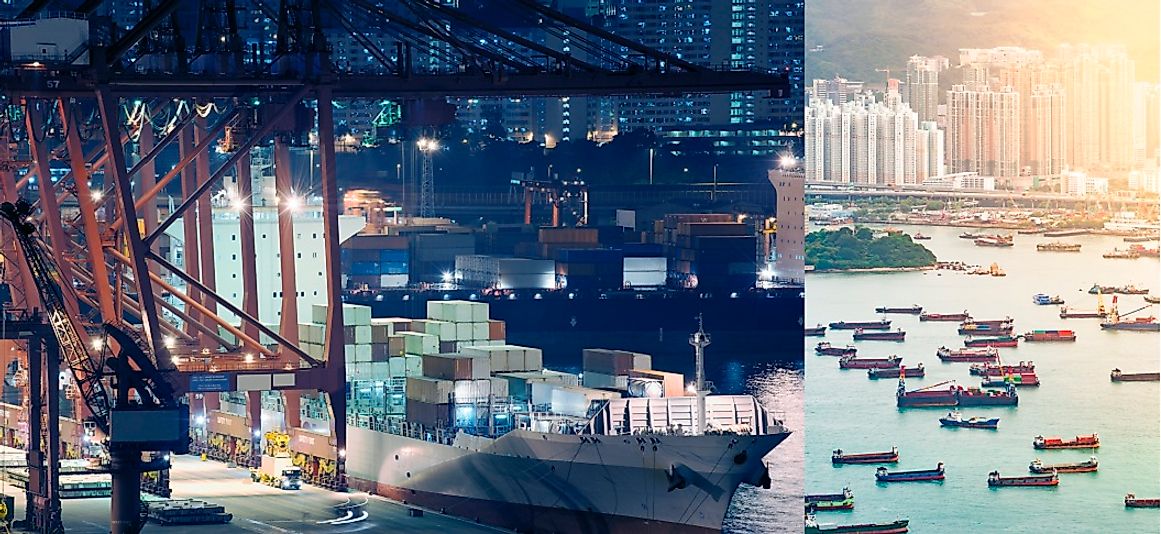National Economies Driven By The Merchandise Trade

Over the past decade, the world economy has trended towards goods and services being traded across borders rather than being preferentially produced, rendered, and sold at home. World trade today has increased threefold since 2002, reaching a level of over $18 trillion USD annually. The global balance is shifting, as developing countries now account for an increasing share of international trade. However, a country's ability to export a particular product depends on its access to natural resources and technology, as well as its relative advantage over other countries in the sectors of production and trade costs.
Some countries have built their national economies around the trade of merchandise. Hong Kong's combined import and export values more than double the country's Gross Domestic Product (GDP), at 345.2%. Singapore isn't far behind at 221.1%. Slovakia, Belgium and Vietnam are at 172.2%, 170.3%, and 169.5%, respectively. The Czech Republic has a combined import and export value of 164.3% of GDP, and Hungary's is 158.4%. Cambodia, the Republic of the Congo and Slovenia also rely heavily on merchandise trade, with values at 146%, 144.9%, and 144.2% relative to GDP.
Hong Kong
Electronics account for almost 50% of Hong Kong's export industry. Gems, precious metals, and machinery are also significant exports in the country. 77.2% of Hong Kong's exports are delivered to Asian trading partners, notably China, Japan, Singapore and South Korea. The US has a strong trade relationship with Hong Kong as well.
Singapore
Electronic equipment comprises 34% of Singapore's exports by value. Oil is another important export as well, and in fact Singapore is Asia's leading oil hub and pricing center. Almost three quarters of Singapore's exports are delivered to other Asian trading partners such as Malaysia, China, Hong Kong, Indonesia, Japan, and South Korea, while 7.3% are traded to North America.
Slovakia
Slovakia's main export category is machinery, which accounts for more than half of the country's output into foreign markets. Other export goods include chemicals, fuel, steel, and weapons. Over 90% of Slovakia's exports are delivered to its European partners, particularly the Czech Republic, Austria, Germany and Russia.
Belgium
More than 80% of Belgium's economic output is comprised of exported goods. The country's top exports are pharmaceuticals and vehicles, followed by oil, chemicals, machinery and plastics. European trading partners benefit from 73.8% of Belgium's exports by value, Asian partners receive 11.3%, and 6.7% is shipped to North America.
Vietnam
More than 20% of Vietnam's exports are shipped to the United States. China receives 11.7%, and Vietnam's trade with China and other Asian countries has been rapidly increasing. Exports include electronics, shoes, machinery, clothing and crude oil.
Czech Republic
The Czech Republic delivers 88% of its exports to other European trading partners, including 31% to Germany alone. Exports include machinery and transport equipment, raw materials, chemicals and fuel.
Hungary
Hungary is the largest electronics producer in Central and Eastern Europe, and 22% of its total exports are based in the electronics industry. Other top exports include machinery and vehicles. Germany is its main trading partner, and most of its exports are sold to other European countries.
Cambodia
Cambodia's garment industry is the country's primary export sector, accounting for 80% of the country's total exports. Over 40% of Cambodia's exports are sent to North America, 24% are delivered to Europe and 7% are shipped to China.
Democratic Republic of the Congo
The economy of the Democratic Republic of the Congo is primarily based on mining and extraction of other natural resources. Gold, diamonds, copper, cobalt, coltan, zinc, tin, tungsten, crude oil, and wood are its principal exports. China is a major trading partner, accounting for 53% of the Congo's exports. Geographical proximity to the region makes Zambia another significant trading partner, taking delivery of 24.5% of the Democratic Republic of the Congo's total exports.
Slovenia
Since the country's independence in 1991, Slovenia has aggressively pursued trade with Western Europe, and in so doing has embraced numerous European and international trade institutions. Major trading partners include Germany, Italy, Austria and Croatia. Vehicles and electronic equipment are the Slovenia's main exports, but machinery, pharmaceuticals and oil are significant exports as well.
A Global Shift Being Fueled By South Asian Markets
Increased demand in developing and middle income countries is having a significant impact on international trade dynamics. Trade between South and Southeast Asian nations in particular has increased significantly over the course of the last decade, and the movement of the Association of Southeast Asian Nations (ASEAN) towards a regional free trade agreement may cause a seismic shift in global trade and economics.
National Economies Driven By The Merchandise Trade
| Rank | Country | Merchandise Trade Relative To GDP |
|---|---|---|
| 1 | Hong Kong | 345.2% |
| 2 | Singapore | 221.1% |
| 3 | Slovakia | 172.2% |
| 4 | Belgium | 170.3% |
| 5 | Vietnam | 169.5% |
| 6 | Czech Republic | 164.3% |
| 7 | Hungary | 158.4% |
| 8 | Cambodia | 146.0% |
| 9 | Republic of the Congo | 144.9% |
| 10 | Slovenia | 144.2% |











